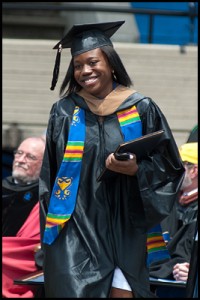During a video interview conducted last fall, Samantha Louis—a senior at Bridgewater State University who will graduate this spring with a degree in Psychology—was asked what might have gone differently if she hadn’t worked with Bottom Line. She described the benefits of campus visits and help filling out the FAFSA, and ultimately replied that she probably would have enrolled in a community college rather than the 4-year university she currently attends.
This isn’t the first time a Bottom Line student has given this answer. Jeanette Sanchez, a senior studying Writing, Literature, and Publishing at Emerson College, said that she would have gone to community college because it had a lower price tag. But with a 4.5 high school GPA and a goal of earning a bachelor’s degree in writing, Jeanette was already well-suited for directly enrolling in a 4-year college. In education lingo, Samantha and Jeanette both said they would have “undermatched” if they had not come to Bottom Line for help with college applications.
The concept of undermatching has been talked about more and more since the release of Crossing the Finish Line: Completing College at America’s Public Universities, written by William G. Bowen, Matthew M. Chingos, and Michael S. McPherson. Undermatching basically means that a student doesn’t enroll in the best college that he/she could have. This problem is particularly prevalent among students from low-income households or the first generation of their family to attend college. As economics columnist David Leonhardt recapped in The New York Times, “about half of low-income students with a high school grade-point average of at least 3.5 and an SAT score of at least 1200 do not attend the best college they could have. Many don’t even apply.”
So why is undermatching a problem? The National Center for Educational Statistics released a study in December 2010 that states only 12% of students who start at community colleges earn a bachelor’s degree within six years. Of the first-time, public 2-year college students who transferred to a 4-year college, 29% attained a bachelor’s degree and 15% remained enrolled at a 4-year college. While many community colleges have effective transfer programs and continue to build partnerships with 4-year colleges, on a broad national scale, your chances of earning a bachelor’s degree are higher if you initially enroll in a 4-year college. In many ways, this is a shorter and less complex journey. For this reason, if your goal is to earn a bachelor’s degree, it makes sense to enroll directly in a 4-year college if you can.
To ensure that the low-income/first-generation students who are qualified to enroll directly into a 4-year college do so, they need a knowledgeable guide to lay out their feasible college options. Having an informed mentor allows students to make decisions based on all the information—information they don’t necessarily have access to through their immediate friends and family or, in some cases, their high schools. By building a relationship with a counselor, these students have someone who will lead them step by step through the inconceivably complex world of higher education.
But undermatching isn’t the only danger for low-income/first-generation students. Helping a student get to the right college is just the first step. Samantha illustrated this when she explained that Bottom Line was on campus every year helping her fill out the FAFSA. She insisted she would have had student loans if it weren’t for this help.
When asked what motivated her to succeed, Samantha said her mother and the fact that she is a minority. “I don’t want to be one of those statistics,” she said. If there’s anything to be learned from Bottom Line students, it’s how ambitious and resilient you have to be to succeed in today’s higher education system. Bottom Line students show that undermatching or dropping out of college doesn’t occur from any lack of motivation or effort.
Bowen, Chingos, and McPherson said they think undermatching is caused by “a combination of inertia, lack of information, lack of forward planning for college, and lack of encouragement.” To address this wide range of reasons, the advice low-income and first-generation students receive needs to be holistic: academic, financial, vocational, and personal. This need is particularly apparent this month as high school seniors from the Class of 2011 are making final decisions about where they will attend college during the next 4 or more years.
While we have a long way to go before our public schools and higher education systems completely adapt to accommodate the needs of the modern-day student, it’s comforting to know that there are solutions brewing, some of them as seemingly simple as offering a one-on-one counselor.



